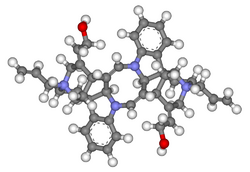Chemistry:Alcuronium chloride
 | |
 | |
| Clinical data | |
|---|---|
| AHFS/Drugs.com | International Drug Names |
| ATC code | |
| Pharmacokinetic data | |
| Metabolism | not metabolized |
| Excretion | 70–90% unchanged in urine 1.3ml/kg/min t1/2 2–4 hours |
| Identifiers | |
| |
| CAS Number | |
| PubChem CID | |
| IUPHAR/BPS | |
| ChemSpider | |
| UNII | |
| ChEBI | |
| Chemical and physical data | |
| Formula | C44H50N4O2+2 |
| Molar mass | 666.894 g/mol g·mol−1 |
| 3D model (JSmol) | |
| |
| |
| | |
Alcuronium chloride is a neuromuscular blocking (NMB) agent, alternatively referred to as a skeletal muscle relaxant. It is a semi-synthetic substance prepared from C-toxiferine I,[1] a bis-quaternary alkaloid obtained from Strychnos toxifera. C-toxiferine I itself has been tested for its pharmacological action and noted to be a very long acting neuromuscular blocking agent[2] For a formal definition of the durations of actions associated with NMB agents, see page for gantacurium. The replacement of both the N-methyl groups with N-allyl moieties yielded N,N-diallyl-bis-nortoxiferine, now recognized as alcuronium (and at one time marketed as the proprietary agent called Alloferin).
Inclusion of the allylic functions presented an enhanced potential area of biotransformation, and thus alcuronium is observed to have a much shorter duration of neuromuscular blocking action than its parent C-toxiferine I.[3] It also has a more rapid onset of action, and is ~1.5 times as potent as tubocurarine.[4] The pharmacological action of alcuronium is readily reversed by neostigmine, and it produced little histamine release.[5] The major disadvantage of alcuronium is that it elicits a vagolytic effect produced by a selective atropine-like blockade of cardiac muscarinic receptors.[4][6][7]
Effects
- Cardiovascular system: histamine release and blockage of the sympathetic ganglia including adrenal medulla could cause hypotension
- Respiratory: apnea due to phrenic blockage but bronchoconstriction can occur from the histamine release
- Central nervous system: no effect on intraoccular pressure
- Autonomic ganglion blockade can cause decrease in gut motility
Special points
- Duration of action prolonged in states of low potassium, calcium and protein, also in states of high magnesium and acidosis.
- Pharmaceutically incompatible with thiopentone
- Infusion can cause fixed dilated pupils
See also
- The International Pharmacopoeia
References
- ↑ Foldes FF (1954). "The Mode of Action of Quaternary Ammonium Type Neuromuscular Blocking Agents". Br. J. Anaesth. 26 (6): 394–398. doi:10.1093/bja/26.6.394.
- ↑ Waser PG (1950). "none". Helv. Physiol. Pharmacol. Acta 8: 342.
- ↑ Martin-Smith M (1971), In: Ariens EJ (ed.), "Drug Design". Vol. 2. Academic Press. New York and London. pp.453-530.
- ↑ 4.0 4.1 "Pancuronium Bromide: A Review of its Pharmacological Properties and Clinical Application". Drugs 4 (3-4): 163–226. 1972. doi:10.2165/00003495-197204030-00002.
- ↑ Thompson MA (1980). "none". Br. J. Hosp Med 23: 153.
- ↑ "The immediate cardiovascular effects of pancuronium, alcuronium and tubocurarine in man". Anaesthesia 27 (4): 415–22. 1972. doi:10.1111/j.1365-2044.1972.tb08247.x. PMID 4264060.
- ↑ "Effects of Non-Depolarizing Neuromuscular Blocking Agents on Peripheral Autonomic Mechanisms in Cats". Br. J. Anaesth. 48 (2): 59–68. 1976. doi:10.1093/bja/48.2.59.
Further reading
- "Allosteric modulation of muscarinic receptor signaling: alcuronium-induced conversion of pilocarpine from an agonist into an antagonist". J Pharmacol Exp Ther 301 (2): 720–8. 2002. doi:10.1124/jpet.301.2.720. PMID 11961078.
- "Opposite effects of alcuronium on agonist and on antagonist binding to muscarinic receptors". Eur J Pharmacol 305 (1-3): 231–4. 1996. doi:10.1016/0014-2999(96)00240-3. PMID 8813558.
- "Protection by alcuronium of muscarinic receptors against chemical inactivation and location of the allosteric binding site for alcuronium". J Neurochem 63 (5): 1932–40. 1994. doi:10.1046/j.1471-4159.1994.63051932.x. PMID 7931349.
- "Mechanisms of steric and cooperative actions of alcuronium on cardiac muscarinic acetylcholine receptors". Mol Pharmacol 45 (4): 709–17. 1994. PMID 8183250.
 |

